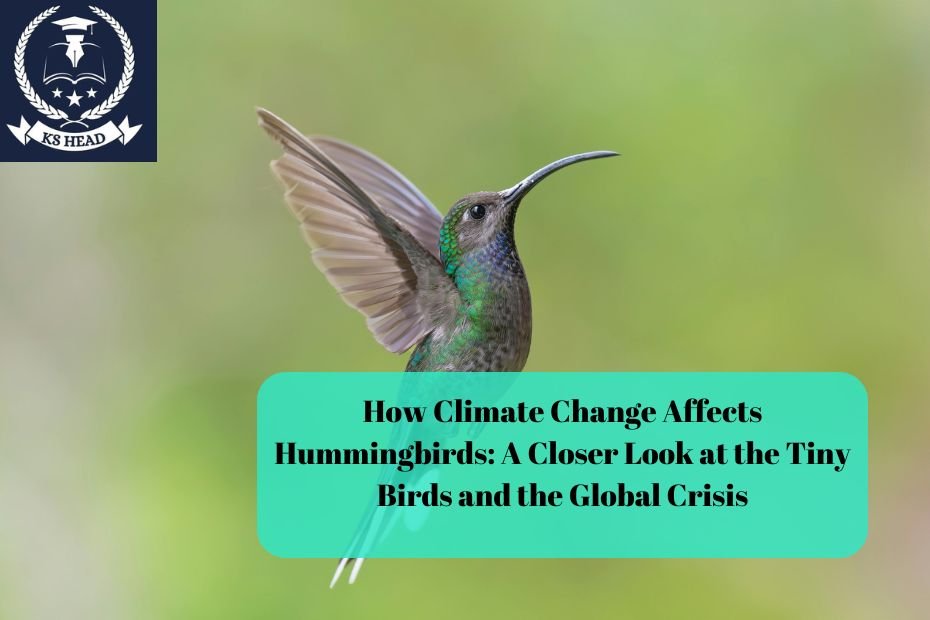Hummingbirds, with their vibrant colors and rapid wing beats, are among nature’s most fascinating creatures. They can hover in place, fly backward, and migrate vast distances. However, like many other species, hummingbirds are increasingly vulnerable to the impacts of climate change. As temperatures rise, ecosystems shift, and extreme weather events become more common, hummingbirds face challenges that threaten their survival. This article delves into how climate change is affecting these delicate birds and what we can do to help protect them.
The Unique Life of a Hummingbird
Before diving into how climate change is affecting hummingbirds, it’s important to understand what makes these birds unique.
- Metabolism: Hummingbirds have the fastest metabolism of any warm-blooded animal, requiring them to consume up to twice their body weight in nectar every day. Their hearts can beat over 1,200 times per minute, and their wings can flap as fast as 80 times per second.
- Migration: Many species of hummingbirds migrate over long distances, with some traveling up to 3,000 miles between breeding grounds in North America and wintering areas in Central and South America.
- Pollination: Hummingbirds play a critical role in pollinating various flowering plants, helping to maintain biodiversity within ecosystems.
Because of their high energy needs and reliance on specific habitats and food sources, hummingbirds are particularly vulnerable to changes in the environment.
The Impact of Climate Change on Hummingbirds
1. Shifts in Flowering Patterns
Hummingbirds rely heavily on nectar from flowers for their energy. They often time their migrations with the blooming of certain flowers to ensure they have enough food. However, climate change is causing many plants to bloom earlier than usual. As temperatures rise, flowers may bloom before hummingbirds arrive at their destinations, leading to a mismatch in timing, known as phenological mismatch. If hummingbirds arrive too late, the flowers may no longer have nectar, leaving the birds without sufficient food.
In contrast, if the flowers bloom too late, the birds may face starvation while waiting for their primary food source to become available.
2. Changing Migration Patterns
As global temperatures rise, hummingbirds are beginning to alter their migration patterns. Warmer winters in some regions may prompt them to migrate earlier in the year or stay in one place for longer periods. However, this shift can be problematic.
Hummingbirds rely on instinct to guide them through long migrations, and sudden changes in climate can disrupt their natural cues, leading to exhaustion or death. Additionally, some regions that are warming may not have the necessary food or habitat to support the hummingbirds throughout the year, forcing them into areas where they cannot thrive.
3. Loss of Habitat
Climate change is causing habitat loss at an alarming rate. Forests, wetlands, and other natural habitats are being destroyed or altered by rising temperatures, extreme weather, and human activity. Hummingbirds, especially those that rely on specific plants or ecosystems, may struggle to find suitable habitats as their environments change.
For example, the rufous hummingbird, which migrates from the Pacific Northwest to Mexico, depends on specific high-altitude habitats along its route. Climate change is affecting these regions, reducing the availability of the plants and insects the birds need to survive. Additionally, deforestation and agricultural expansion are shrinking the size of forests where hummingbirds nest and feed, making it harder for them to find safe spaces.
4. Extreme Weather Events
The increasing frequency and intensity of extreme weather events due to climate change are also taking a toll on hummingbirds. Hurricanes, droughts, and storms can devastate their habitats and wipe out food sources.
Droughts, in particular, can be catastrophic for hummingbirds because they rely on water and nectar to stay hydrated and energized. Without adequate rainfall, flowers may not produce enough nectar, leaving hummingbirds without their primary source of food. Drought can also reduce the number of insects available, which hummingbirds rely on for protein.
In some cases, storms can destroy nests or knock hummingbirds off course during migration, resulting in fatalities.
5. Higher Temperatures and Metabolism
Hummingbirds have a rapid metabolism and are highly sensitive to temperature changes. As global temperatures rise, hummingbirds may need to expend more energy to regulate their body temperature, which could increase their already high caloric needs. In hotter conditions, they might also struggle to find the shade or cool areas necessary to rest and recover, increasing their risk of exhaustion or heat stress.
6. Decline in Insect Populations
While nectar is their primary food source, hummingbirds also consume small insects and spiders, especially during breeding seasons when they need protein to feed their young. Climate change is causing a decline in insect populations due to habitat loss, pesticide use, and changing temperatures.
Without adequate insect populations, hummingbirds may struggle to get the nutrients they need, especially when rearing their chicks. A lack of insects could also force hummingbirds to travel farther in search of food, increasing their energy expenditure and stress levels.
Conservation Efforts to Help Hummingbirds
Fortunately, there are steps that can be taken to mitigate the impact of climate change on hummingbirds. Conservation efforts are crucial to ensuring their survival.
1. Planting Native Flowers
One of the most effective ways to help hummingbirds is by planting native flowers in your garden or community. These plants provide essential nectar and attract insects that hummingbirds rely on for food. Native plants are better adapted to local climates and require less water and maintenance, making them a sustainable option. Some excellent hummingbird-friendly plants include bee balm, columbine, and trumpet vine.
2. Providing Feeders
Hummingbird feeders can provide a valuable source of food, especially during migration or in areas where natural nectar sources are limited. Use a mixture of one part sugar to four parts water, and avoid using red dye, as it can be harmful to birds. Be sure to clean feeders regularly to prevent mold and bacterial growth.
3. Protecting Habitats
Supporting efforts to protect and restore natural habitats is crucial to ensuring that hummingbirds have access to the resources they need. This includes preserving forests, wetlands, and other ecosystems that are vital to their survival. Conservation groups are working to establish protected areas and corridors that allow hummingbirds to migrate safely and access food along their journey.
4. Advocating for Climate Action
Addressing the root cause of climate change is essential for protecting hummingbirds and countless other species. Supporting policies that reduce carbon emissions, promote renewable energy, and protect natural ecosystems is critical to slowing the pace of climate change. By advocating for climate action at the local, national, and international levels, individuals can help create a more sustainable future for hummingbirds and the planet as a whole.
5. Monitoring Hummingbird Populations
Citizen science projects, such as Journey North and Hummingbirds at Home, allow individuals to contribute to hummingbird conservation by monitoring their movements and populations. By reporting sightings and behaviors, people can help researchers track how climate change is affecting hummingbirds and identify areas where they need the most help.
Conclusion
Hummingbirds are remarkable creatures, but they are increasingly vulnerable to the impacts of climate change. Shifts in flowering patterns, changing migration routes, habitat loss, extreme weather events, and higher temperatures are all putting pressure on these tiny birds. However, through conservation efforts such as planting native flowers, providing feeders, and protecting habitats, we can help hummingbirds survive and thrive in a changing world. Advocacy for climate action and participation in citizen science projects can further contribute to their conservation. By working together, we can ensure that future generations continue to enjoy the beauty and wonder of hummingbirds.
FAQs
1. How does climate change affect hummingbird migration?
Climate change can cause hummingbirds to migrate earlier or later than usual, disrupting their timing with food sources such as flowering plants.
2. What can I do to help hummingbirds affected by climate change?
You can plant native flowers, provide hummingbird feeders, support habitat conservation efforts, and advocate for climate action.
3. Do hummingbirds eat anything besides nectar?
Yes, in addition to nectar, hummingbirds consume small insects and spiders, especially when they need protein for themselves and their chicks.
4. How does rising temperature impact hummingbirds?
Higher temperatures increase hummingbirds’ energy expenditure as they work to regulate their body temperature, which can lead to exhaustion and heat stress.
5. Why are insect populations important for hummingbirds?
Insects provide essential protein for hummingbirds, particularly during breeding season. A decline in insect populations can negatively affect their nutrition and survival.

